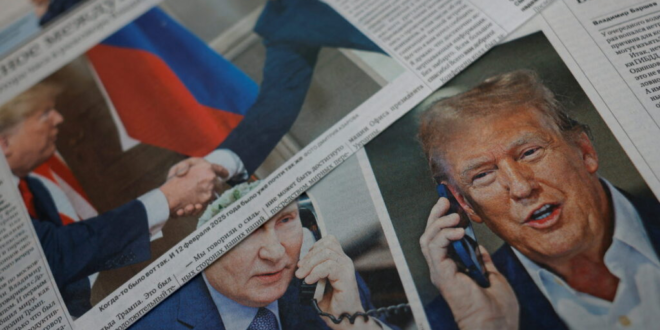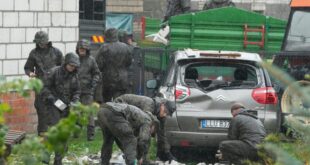For months, US President Donald Trump and allies such as Senator Lindsey Graham have stated that if Russian President Vladimir Putin rejects peace efforts, the United States will impose new sanctions to bring Russia to the negotiating table. So far, however, the Kremlin has refused to join Ukraine in accepting a US-proposed ceasefire. Instead, Putin has this week demanded sanctions relief in exchange for a limited maritime ceasefire that favors Russia. It may now be time to consider putting more pressure on Moscow.
Putin certainly does not appear to be very interested in ending the war. Since agreeing to a pause on energy infrastructure attacks during a March 18 call with Trump, he has launched multiple large-scale drone and missile bombardments of Ukrainian civilian and energy targets.
If the US uses sanctions alone to pressure Putin, the impact will not be felt immediately. In order to get the Russian leader’s attention, new sanctions must be paired with tougher enforcement of existing sanctions and expanded military assistance to put Ukraine in a better position on the battlefield. More than anything else, the military reality on the ground in Ukraine is the deciding factor in efforts to end the war. Luckily, this is the area where Trump has the greatest ability to shape perceptions.
Republicans in Congress have shown an interest in expanding sanctions against Russia, particularly in going after Moscow’s energy revenues while boosting US energy exports to cut into Putin’s war chest. Any legislation to make good on these objectives should also include new appropriations for the Presidential Drawdown Authority so that Trump can send armored vehicles, long-range fires, air defenses, and more to Ukraine, while also backfilling US stocks with new replacements.
Legislative steps could also include funding for the Ukraine Security Assistance Initiative. This would allow the president to issue contracts for new weapons that will benefit Ukraine, while creating jobs for US manufacturers and revitalizing the domestic defense industrial base.
Passing new military assistance would send a much-needed signal of resolve after two months of softball tactics from the Trump administration toward Russia. A record high number of Americans currently think Trump is doing too little to help Ukraine and believe he is siding with Russia. Trump’s Special Envoy Steve Witkoff recently added to these concerns by uncritically repeating a series of false narratives used by the Kremlin to justify the invasion of Ukraine during an interview with Tucker Carlson.
Members of Trump’s team have already outlined arguments in favor of more military aid to Ukraine. Last April, Special Envoy for Ukraine Keith Kellogg wrote that if Kyiv wouldn’t come to the table for talks, the US should withhold military assistance, while if Russia refused to negotiate, aid to Ukraine should be increased. Trump has since followed through on cutting aid to Ukraine, but resumed deliveries after Kyiv declared it was ready to accept Trump’s proposal for an unconditional ceasefire.
With Ukraine now backing Trump’s ceasefire proposal while Putin keeps finding new reasons to delay, it is difficult to avoid the conclusion that Russia is the main obstacle to peace. The recently announced ceasefire in the Black Sea is far from Trump’s original proposal, with the Russians requiring sanctions relief before implementing it. Putin has sought to introduce his own ceasefire conditions, while also demanding “the complete cessation of foreign military aid and the provision of intelligence information to Kyiv.” This would leave Ukraine isolated and disarmed in exchange for a pause in the fighting.
Trump should respond to Putin’s stalling tactics by following the recommendations of his own secretary of state, who said back in January that Ukraine needed greater leverage over Russia. That means changing Putin’s calculus on the battlefield and stopping the Russian military’s grinding advances.
Eurasia Center events
Strengthening Ukraine’s position on the battlefield could be politically advantageous for Trump. Former US President Joe Biden was long criticized for his flawed approach to providing Ukraine with military assistance. As a result of Biden’s cautious policies, Ukraine received enough to survive but not to win.
Trump could now correct Biden’s mistake by making an historic presidential drawdown and surging military assistance to Ukraine in order to bring Russia to the table. He could also use the REPO Act to make Russia’s own frozen assets pay for any new aid, an idea Speaker Mike Johnson has previously called “pure poetry.”
Russia is not yet ready to enter into serious peace talks, but Putin is in a vulnerable position. He is sacrificing huge numbers of soldiers for modest gains in Ukraine, and is struggling to replace the large quantities of military equipment being lost in costly frontal offensives. Domestically, the Russian economy is showing signs of strain, with high inflation and a shortage of workers.
Despite this deteriorating outlook, Putin is still betting that he can outlast the West in Ukraine. With continued US support for Ukraine in question and deep divisions emerging within the transatlantic alliance, he now has less reason than ever to compromise.
In Trump’s book, The Art of the Deal, he argues that the best way to negotiate is to “just keep pushing and pushing and pushing to get what I want.” So far, we’ve seen the president exert massive pressure on Ukraine by pausing aid, siding with Moscow at the UN, and even calling Zelenskyy a dictator. We’ve yet to see similar pressure on Russia.
Putin’s approach to negotiations currently resembles The Art of the Deal far more than Trump’s. The Russian dictator is pushing and pushing for further concessions, while offering very little in return. If Trump wants to achieve a genuine peace, he will need to put far more pressure on Moscow. Increased sanctions are a necessary step, but giving Ukraine the weapons it needs to push Russia back on the battlefield will likely prove far more effective.
 Eurasia Press & News
Eurasia Press & News




